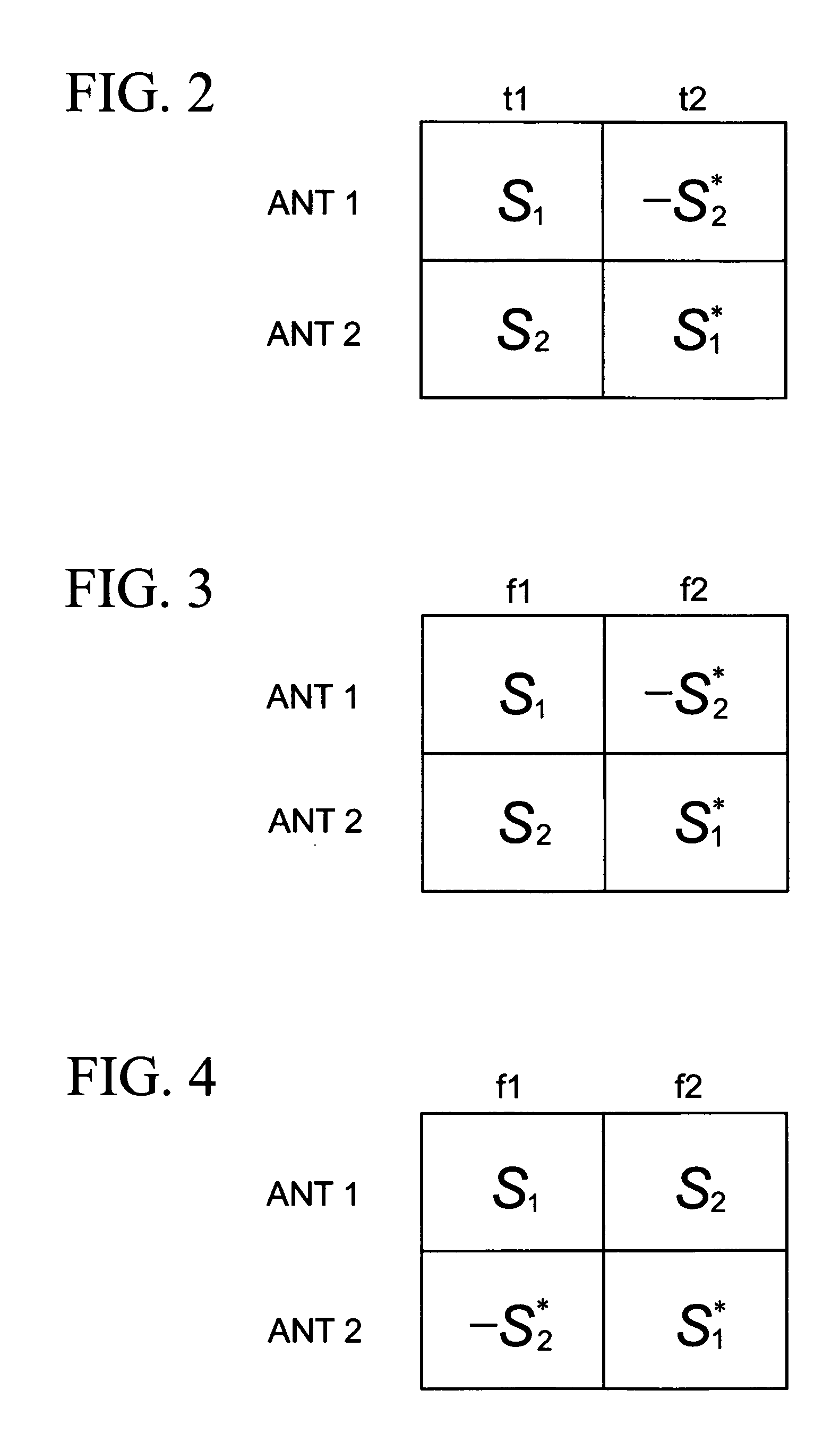Transmit diversity in a wireless communication system
a wireless communication system and diversity technology, applied in diversity/multi-antenna systems, multi-frequency code systems, digital transmission, etc., can solve the problems of small changes in differential propagation delays, large changes in individual wave phases, and the scheme cannot be applied to two transmission antennas
- Summary
- Abstract
- Description
- Claims
- Application Information
AI Technical Summary
Benefits of technology
Problems solved by technology
Method used
Image
Examples
first embodiment
[0069]In a first embodiment according to the principles of the present invention, we assume that four symbols S1, S2, S3 and S4 are transmitted on four subcarriers using four transmission antennas. Let us define matrix A and B as below.
A=12[S1-S2*S2S1*]B=12[S3-S4*S4S3*](22)
[0070]It can be seen that each matrix A and B is an Alamouti code for the pair of symbols S1 and S2, and the pair of symbols S3 and S4, respectively. We construct a 2×2 matrix with A and B as its elements and perform an element-by-element multiplication with an expanded 2×2 Fourier matrix as below. Note that the operator .* formed by a period immediately followed by an asterisk denotes element-wise multiplication and denotes kronecker product.
Ti=12[AABB]·*(P2i[1111]),fori=1,…,12.(23)
[0071]For i=0 case, the resulting 4×4 matrix denoting discrete Fourier transform DFT-spread SFBC or DFT-spread STBC is given as below.
T0=12[AABB]·*(P20[1111])=12[AABB]·*(12[111-1][1111])=14[S1-S2*S1-S2*S2S1*S2S1*S3-S4*-S3S4*S4S3*-S4-S...
second embodiment
[0076]In a second embodiment according to the principles of the present invention, we exchange the second row and the third row of Ti, thus resulting in a new SFBC matrix called Ti,r. Ti,r is useful for evening out pilot-density disparity inherent in the reference signal structure of the LTE system. For example, T0,r is given by the following.
T0,r=14[S1-S2*S1-S2*S3-S4*-S3S4*S2S1*S2S1*S4S3*-S4-S3*](27)
[0077]FIG. 9 is an illustration of the transmission diversity scheme for four transmission antennas and four time slots according to Equation (27) in the second embodiment of the principles of the present invention.
third embodiment
[0078]In a third embodiment according to the principles of the present invention, we propose to exchange the second and the third row of the SFBC-FSTD matrix as shown in Equation (8), thus resulting in new SFBC matrix. By this operation, symbols S1 and S2 are transmitted over antennas ports 0 and 2 while symbols S3 and S4 are transmitted over antenna ports 1 and 3 as given by the transmit matrix below. Again, this is useful for evening out pilot-density disparity inherent in the reference signal structure of the LTE system.
[S1-S2*0000S3-S4*S2S1*0000S4S3*](28)
[0079]FIG. 10 is an illustration of the transmission diversity scheme for four transmission antennas and four time slots according to Equation (28) as in the third embodiment of the principles of the present invention.
PUM
 Login to View More
Login to View More Abstract
Description
Claims
Application Information
 Login to View More
Login to View More - R&D
- Intellectual Property
- Life Sciences
- Materials
- Tech Scout
- Unparalleled Data Quality
- Higher Quality Content
- 60% Fewer Hallucinations
Browse by: Latest US Patents, China's latest patents, Technical Efficacy Thesaurus, Application Domain, Technology Topic, Popular Technical Reports.
© 2025 PatSnap. All rights reserved.Legal|Privacy policy|Modern Slavery Act Transparency Statement|Sitemap|About US| Contact US: help@patsnap.com



